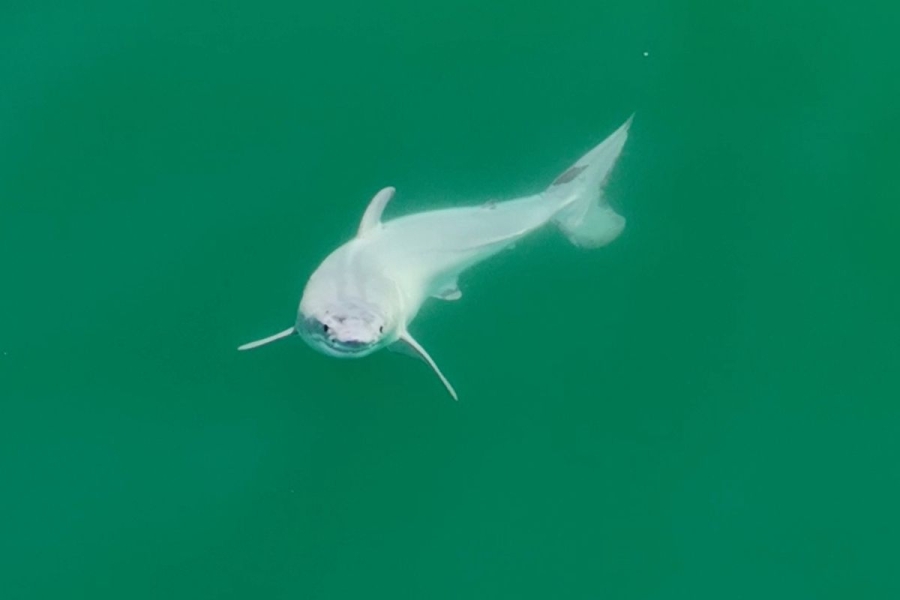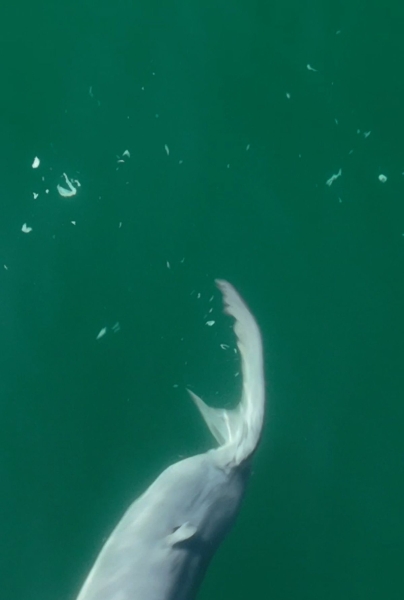Scientists have never seen a newborn great white shark … until (maybe) now.

Benji Jones is a senior environmental reporter at Vox, covering biodiversity loss and climate change. Before joining Vox, he was a senior energy reporter at Insider. Benji previously worked as a wildlife researcher.
Spotting a great white shark only 1,000 feet from the beach is usually quite scary. On rare occasion, these apex predators, which can reach 20 feet long and weigh two tons, bite people.
But that wasn’t the case last summer, when a great white was seen near Santa Barbara, California — because the shark was a baby. At roughly five feet long, the marine animal was possibly only hours old.
This observation is now causing a stir among marine biologists. That’s because, in a newly published paper, a researcher and filmmaker who caught the animal on camera suggest that this shark isn’t just young but a newborn. That would make it the first newborn great white ever observed in recorded history.
In a video captured by nature filmmaker Carlos Gauna, you can see what the authors describe as an indication of infancy: The young shark is shedding a milky white substance that could be remnants of “uterine milk” that mother sharks produce while they’re gestating their babies, according to Phillip Sternes, a doctoral researcher at UC Riverside and an author on the paper. (Sternes was with Gauna when the filmmaker’s drone spotted the shark.)
The duo presented other evidence that the shark is a newborn: The animal not only looked like a baby, with rounded features, but it was also in an area where scientists believe white sharks pup. (Yes, delightfully, shark babies are called pups). Plus, Gauna observed large white sharks that he said looked pregnant in this very spot in the days before their observation.
Not everyone is convinced that the shark is a newborn.
“There is absolutely no doubt that it is a very young white shark,” Gavin Naylor, a shark researcher at the University of Florida, told Vox via email. As for whether it’s a newborn, he added: “It seems more likely (to me) that this young animal may have been a couple of weeks old and strayed into shallow water.”
There are a few details here that make a convincing counter: According to Naylor, the few pregnant white sharks that scientists have dissected don’t appear to have the sort of white fluid that was coming off the baby shark. White sharks also typically give birth to a litter of eight to 12 pups, not just one, so you might expect that other, newly born babies would be swimming nearby.
In the paper, Sternes and Gauna acknowledge that the white substance peeling off the shark could be caused by some unknown skin disorder, and not an indication that it’s a newborn.

But what is clear from the observation — and from the reaction to it — is that our understanding of even the world’s most charismatic species is still full of holes. “Despite the high level of interest, there remain some major gaps in white shark life history,” Sternes and Gauna wrote in their paper. (One reason: It’s really hard to keep white sharks in captivity.)
And it’s not just white sharks that are mysterious, Naylor said. Whale sharks, the world’s largest fish, can give birth to up to 300 pups at a time and scientists don’t know where it happens, he said.
“We know much less than people assume about most of the life forms on earth,” Naylor said. “Determining exactly where different species of sharks give birth is one of hundreds of millions of things we don’t yet know.”
These gaps in our understanding are humbling, no doubt — parts of the world are still unknown, there are still frontiers to explore. Yet they also represent a weakness in our efforts to safeguard life on Earth. A lack of scientific knowledge about species makes it hard to implement the right kind of conservation. Put simply, it’s challenging to protect sharks if you don’t have a picture of something as fundamental as where their lives begin.
The global population of white sharks appears to be declining, at least in some regions, according to the International Union for Conservation of Nature. IUCN, an authority on endangered species, lists the species as “vulnerable.” Yet they are not federally listed as endangered in the US. And in California, data suggests that the white shark population may be increasing, making it something of a stronghold for the species.
“If this is indeed a newborn individual, this demonstrates the critical importance of this area in Southern California to Eastern Pacific white sharks,” wrote Sternes and Gauna in the paper. While California’s white sharks are protected by federal regulations, they still get caught accidentally, they said, which can cause harm and potentially even death.
“Further research is needed to confirm these waters are indeed a great white breeding ground,” Sternes said in a statement. “But if it does, we would want lawmakers to step in and protect these waters to help white sharks keep thriving.”
Source: vox.com






